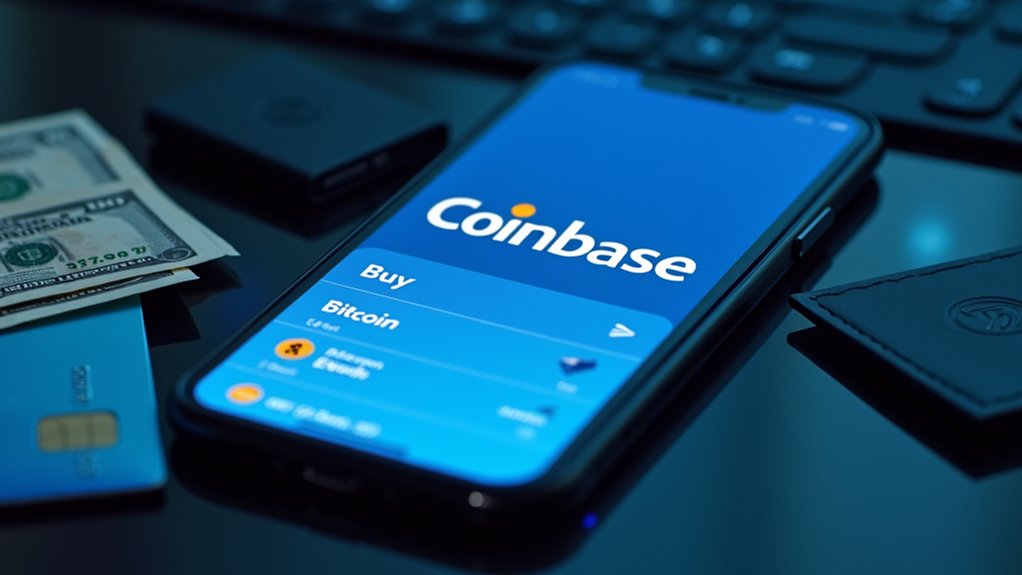Purchasing cryptocurrency on Coinbase requires creating an account, completing KYC verification, and linking a payment method like a bank account or debit card. Users select the "Buy" function, choose their desired cryptocurrency, specify the purchase amount, and review applicable fees before confirming the transaction. Bank transfers typically incur lower fees compared to card purchases, making them preferable for cost-conscious investors. Enhanced security through two-factor authentication protects investments after acquisition, while additional platform features offer various post-purchase options.

Purchasing cryptocurrency through Coinbase, one of the most established digital asset exchanges in the market, involves a structured process that combines regulatory compliance with user-friendly usability. The initial step requires creating an account via the company's mobile application or website, followed by completing the mandatory Know Your Customer (KYC) verification process, which necessitates submission of valid identification documents and, in certain jurisdictions, proof of address documentation. Verification timelines fluctuate based on geographical location and the quality of submitted documentation, while the platform's consistent interface guarantees similar functionality across both mobile and web environments.
Navigating Coinbase's account creation balances regulatory requirements with intuitive design to ensure compliant cryptocurrency acquisition for global users.
Coinbase accommodates various payment methodologies, including bank account linkages, debit card connections, and wire transfers, with bank deposits generally incurring lower transaction fees compared to card-based purchases. Users establish these payment channels through profile settings, with PayPal incorporation available exclusively to US-based customers, and specialized gift card redemption options limited to the domestic American market.
The transaction procedure commences with selecting the "Buy" function on the platform's interface, followed by asset selection from the available cryptocurrency inventory. Transaction execution requires specifying purchase amounts in either fiat currency or crypto equivalent values, followed by a thorough preview stage displaying applicable fees and current exchange rates before final confirmation. The platform offers access to recently added cryptocurrencies through their regularly updated asset listings.
The platform's fee structure includes spread fees, regulatory assessments, and network transaction costs, with variation occurring based on the selected payment methodology and transaction size. All fee disclosures manifest during the preview phase, providing transparency before commitment to the purchase. These costs are important to review as understanding fee structures before finalizing transactions is essential to avoid common cryptocurrency buying mistakes. The reverse process of selling crypto is equally streamlined, allowing users to convert their digital assets back to local currency by selecting the appropriate cryptocurrency and amount through the "Buy & Sell" menu option.
Security protocols constitute an essential component of the Coinbase ecosystem, with recommendations including two-factor authentication implementation, robust password utilization, and avoidance of recovery phrase disclosure.
Post-acquisition options include portfolio tracking, staking eligible assets for passive income generation, external wallet transfers, and establishing recurring investment schedules. The platform further facilitates inter-cryptocurrency conversions through its dedicated "Convert" functionality, allowing portfolio diversification without requiring fiat currency intermediation.
Frequently Asked Questions
What Are the Tax Implications of Buying Crypto on Coinbase?
Purchasing cryptocurrency on Coinbase does not trigger immediate tax liability; however, the transaction establishes a cost basis, which includes the acquisition price plus any associated fees or spreads.
This basis becomes essential for calculating capital gains or losses when the assets are eventually sold, traded, or used.
The IRS classifies cryptocurrency as property, subjecting dispositions to capital gains taxation based on holding period and the difference between cost basis and disposal value.
How Does Coinbase Protect Users From Potential Hacks?
Coinbase implements a multi-layered security infrastructure, storing 98% of crypto assets in offline cold storage to mitigate hacking risks.
The platform employs AES-256 encryption for all data, mandates two-factor authentication, and offers insured hot wallets against theft.
Additional protections include MultiSig technology requiring multiple approvals for withdrawals, biometric verification systems, and geographically distributed encrypted storage solutions.
Regulatory compliance through KYC/AML procedures and BitLicense adherence further strengthens the platform's security posture in light of potential breaches.
Can I Transfer Existing Crypto From Another Wallet to Coinbase?
Users can transfer existing cryptocurrency from external wallets to their Coinbase account through a straightforward process involving the copying or scanning of their Coinbase Wallet public address.
When initiating transfers, users must verify network compatibility, since incompatible networks may result in permanent loss of funds.
The process incurs blockchain-specific network fees, which vary based on congestion and desired transaction speed, with these fees being paid to network validators rather than Coinbase itself.
Are There Withdrawal Limits on Coinbase for Beginners?
Yes, Coinbase implements tiered withdrawal limits for beginners based on verification level.
New users with basic Level 1 verification face the most restrictive limits, which increase substantially upon completing Level 2 and Level 3 verification processes.
Daily withdrawal limits replenish every 24 hours, while weekly limits reset after 7 days.
These constraints vary according to account age, transaction history, geographic location, and the specific payment methods utilized for withdrawals.
Does Coinbase Offer Staking Rewards for Certain Cryptocurrencies?
Coinbase does offer staking rewards for several cryptocurrencies, including Ethereum with an estimated reward rate of 2.40%, Solana, Cardano, Cosmos, and Polkadot.
Each asset features distinct payout schedules, minimum requirements, and unstaking timeframes; for instance, ETH rewards distribute every 3 days while SOL pays every 5 days.
Geographic restrictions apply, with several U.S. states excluded, and users must maintain accounts in good standing to participate in the program.









